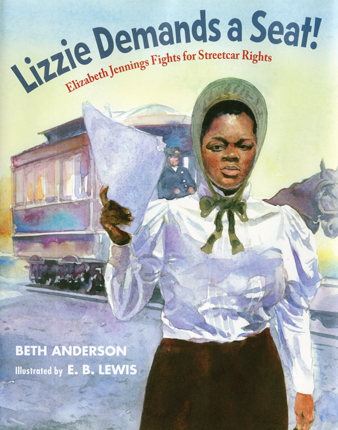| Lizzie demands a seat! : Elizabeth Jennings fights for streetcar rights Author: Anderson, Beth | ||
| Price: $23.08 | ||
Summary:
"Lizzie" Jennings tried to board a streetcar in New York City on her way to church. She was denied entry and decided to fight back.
| Illustrator: | Lewis, E. B. |
| Accelerated Reader Information: Interest Level: LG Reading Level: 3.70 Points: .5 Quiz: 507860 |
Reviews:
Kirkus Reviews (+) (12/01/19)
School Library Journal (+) (02/01/20)
Booklist (+) (12/15/19)
Full Text Reviews:
Booklist - 12/15/2019 *Starred Review* In 1854, a young Black church organist named Elizabeth “Lizzie” Jennings boarded a horse-drawn streetcar in New York City. The conductor objected, insisting that she wait for another streetcar, one displaying a “Colored People Allowed” sign. As a crowd of pedestrians gathered, he relented, delivering a stern warning. When Jennings objected to his rudeness, he dragged her across the platform and dropped her to the curb. She boarded the car again, but the conductor hailed a police officer, who forced her off. A passenger gave Jennings his card, offering to be a witness in court. Though similar legal cases had failed, Jennings sued the streetcar company and won the case, inspiring some of her contemporaries to stand up for their rights as well. An informative author’s note describes Jennings’ family background in the abolitionist movement, her court case, and her place in civil-rights history. Anderson's vivid, well-researched narrative includes dialogue that “closely follows” accounts of Jennings’ experience that appeared in newspapers at the time. Using brighter hues than his usual palette, Lewis creates a series of vibrant, expressive watercolor paintings that transports viewers back in time, while portraying characters as distinct individuals. A memorable picture book introducing a nineteenth-century defender of civil rights. - Copyright 2019 Booklist.
School Library Journal - 02/01/2020 Gr 1–3—In 1854, when Lizzie Jennings was forced off a traditionally "whites only" streetcar, she went to court, winning the right for all black passengers to ride in the same car with white people on the Third Avenue Railroad in New York City. Anderson's account of Jennings's early civil rights triumph stresses the teacher and choir director's determination. An afterword explains how this free, educated, and wealthy black woman was uniquely positioned to succeed where an earlier court case had failed, and how the fight continued for 10 more years before all New York street car companies stopped having separate cars for black and white passengers. Set on spreads with full-bleed illustrations, the storytelling is straightforward and direct. Dialogue closely follows contemporary newspaper accounts to enliven the historical moment. The well-chosen language—"She'd been rejected, restricted, and refused by schools, restaurants, and theaters"—is a pleasure to read aloud. Departing from the somber palette he used for Jabari Asim's Preaching to the Chickens, Lewis employs pastel colors, shades of blues, pinks, and purples, and plenty of background yellow to portray the characters and their surroundings. This lightens the story and supports its positive outcome. Shadowy background figures remind careful readers of the larger community that supported Jennings and were affected. Pair with Nikki Giovanni's Rosa Parks for a reminder of how long this struggle continued. VERDICT An important story beautifully told.—Kathleen Isaacs, Children's Literature Specialist, Pasadena, MD - Copyright 2020 Publishers Weekly, Library Journal and/or School Library Journal used with permission.



